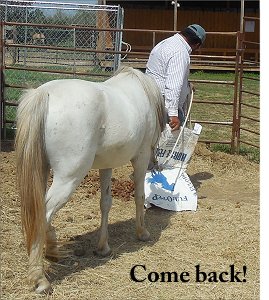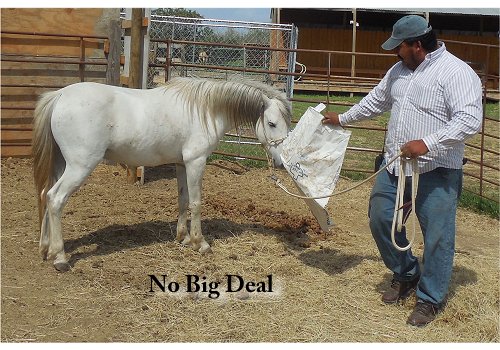How are you going to rob a bank?
Now that you are spending more time with your horse up close and personal, it is time for more de-sensitizing. He’s met your training tools. He’s learned to wear a halter, move away from you, move around you, and move his head up, down, and sideways at your request. All of this has been done without many distractions in the relative safety of the round pen.
There’s literally no end to the de-sensitizing a horse will need over his lifetime. A good trail horse will encounter many natural and man-made obstacles in his journeys. He’s got to take them in stride, trusting you and keeping his head in the face of first-encounters. He must be like a fine-tuned car with you in the driver’s seat. It takes maintenance, imagination, patience, and persistence to obtain the safe and easy horse you want.
A horse who is asked to confront a scary object or tolerate a scary feeling in under pressure. Relief from pressure is a strong motivator. A horse at liberty can give himself his own reinforcement using “distance”. He can retreat as far from the object of his fear as it takes to calm his fear. In that case, he is calming himself without your intervention. Whenever you are purposely de-sensitizing him, it is imperative that you find his comfortable distance from the object first. Proceed to move the object from his comfort zone toward him in Baby Steps, taking care to stop each time he notices the object, has a slight negative reaction to it, but manages to calm himself. Reward his relaxed state of mind by halting the progression so his nervous system can catch up.
It is perfectly good idea to induce him to get to a slight state of nervousness and then allow him to “come down” again. It will enlarge his capacity to regulate his fears and gain confidence. When he licks and chews as the ultimate response to a fear-inducing experience, it is his ultimate self-flooding of good endorphins rewarding his calm state by himself.
Let’s Get to Work
How does he react to your hands and your body in strange dances? You’ve already rubbed his face and body with your hands, the training stick, and your rope. Now go over him with a fine tooth comb. Touch everywhere. Notice where he likes to be touched and where he does not. Horses have places on their bodies they protect more than others. I call them “oh,no!” spots. His withers and shoulders are usually pretty safe. “Oh,no’s” are most frequently found near the ears, in the flank, under the belly. Flinches show problems. Let’s work them through.
Approach and touch/rub/pat the “oh, no”. If he jumps away, follow him but keep touching until he stops moving. Relax. Lower your energy a little and do it again. Expect him to move away again. Start in a “safe” area, then work your way to the “OH,no!”. Pat, pat, pat until he stops moving and the flinch goes away. Relax to let him compose himself and regulate his nervous system back down. Then start again. Ad infinitum.
You should be able to jump around, slap and pat everywhere. He should look positively bored as you do this over his entire body.
Reign, the bay horse in the video, is a gentle horse who learned this exercise in just two 3-minutes sessions. Waters, the young pinto, was having his first pat down. Neither horse is very reactive. I started more carefully with Waters: slower, less active and loud. He had more Oh.no flinchy spots than the video makes clear.
Practice some of these exercises every time you handle your horse, paying particular attention to flinching or touchy areas. You will know which ones the horse has the most problem with. If he doesn’t particularly like you around his head, work more in that area. If he moves away from having his flank touched, work there.

The mare in the photos is having her teats rubbed and manipulated because she will be foaling in about 60 days. We want her to be relaxed about both ourselves and her foal rubbing and butting that spot. She is also practicing having her tail pulled. If she pulls against me and moves, I hold on until she stops moving and relaxes. (Use some common sense here. Don’t get behind a horse who might kick. Even though I doubt that this mare will ever kick, you can see that I am out of the kicking zone.)
How are you going to rob the Wells Fargo office, run out the door with the loot in one hand, your six-shooter in the other, and out-distance the posse on a horse that will not stand still while you charge at him insanely to make your get-away?
More importantly, if you ever find yourself on the wrong side of your horse (looking up at your horse instead of on top of him), it is important that your horse stands still while you get up and get his reins. A horse who is desensitized to a falling saddle (simulating a falling rider) under or behind or in front of him is more likely to stand his position while you get your wits about you. He will stop and allow you or someone else to run up and catch him in the event of a spill.
Here’s how to get that stock-still horse. Practice running up to him quickly, pet his face or rub his cheeks, then retreat. Nothing bad ever happens when you run to or at him. Just a nice face rub. Your job is not done until he is approachable, touchable, huggable – steady as a rock no matter what you are doing.
Kristull Reign is a model of tolerance after just two, 3-minute sessions. Very sensitive, re-active horses may jump around a lot more: skitz away. Using your rope, keep their head toward you and rub. Then repeat. I, personally, have never encountered a rearing horse. If he is that wild or disrespectful, he is not ready for this lesson.
Lazy horses usually tolerate very well after an initial head-raising startle. Disrespectful horses may try to push into your space. Keep your “Power Bubble” intact.
De-sensitizing to Environmental Objects
SLOW AND LOW
Now try some “scary” objects such as a grain sack and then a plastic bag. Be prepared. These can be very frightening to a horse. (See this little Caspian stallion learn about the grain sack)

Start far away at a 45 degree angle to his front. Flap and swing the bag low while holding the lead so his head is tipped toward you (to avoid his rear) but let him have a little slack to retreat from the object. He will try to retreat to a “safe” zone where he does not feel threatened.
Follow (but don’t chase) his flight to get away until he stops and relaxes. If he seems too frightened to manage, let him relax to calm down, then lower the bag to the ground, and drag it away from him. A scary object running away from a horse becomes a curiosity. He won’t be able to stop looking at it and ultimately following it.

As his curiosity gets the better of him, let him approach the bag, smell it, and taste it if he wants to. Then start moving it away again. Do this a few times until he is bored. When he no longer reacts, start moving it toward him again. Find his fear spot. Approach to that spot and a little closer. Follow him as he moves, but don’t make him frantic.
Stop immediately when he stops and relaxes – even drag it away again if he stops. Then approach a little closer. Stop when he stands still and relaxes. Remember, SLOW and LOW.
Approach, retreat, relax as many times as it takes to get him to stand still. Then begin to raise it higher on his body until you can flap it, swing it, touch and rub him all over with it and it’s “No big deal”.

Arabs and other particularly hot, emotive horses may have to repeat this time after time, day after day. They take much more precise timing and a lot of patience.
You can de-sensitize a horse to anything if you start SLOW and LOW. Give him a chance to approach the situation slowly, seeing, touching, smelling, and tasting anything that scares him. If he learns to stand still whenever he sees anything frightening (not a natural instinct), then you will win the spook-and-run game right here on the ground. You can turn it into stand-and-face.

Use your imagination. Teach him to walk across a tarp, approach a big ball, step over boards and logs, walk through water. It all works the same way. Approach – Retreat – Relax. Slow and Low.
De-sensitizing to situations: Once my horse is able to walk calmly on a lead and has respect for my space, I start taking him on walking journeys with me – all around the ranch grazing, training and working areas. We bond during these trips. I separate him from his pasture mates during our training weeks, so that I am his only friend. He welcomes the relief from the boredom of his solitary paddock. When I arrive he gets exposed to the activities of other people in some of the busier areas. Each new area presents new challenges and discomforts that we overcome together.

 The Rare and Endangered Caspian Horses I use in many of these pictures, spend hours and hours with me. This one followed as we built a new barn. It was like taking a big dog everywhere I went. Skill saws, hammering, boards dropping, echoes and shouting became absolutely common place to him. We played body-touching games at every opportunity – I tried to duplicate how a child will ultimately hang on him, pat him, climb around him, make sudden movements etc. Nothing could scare this little guy. And I didn’t even feel like we had been training. Just me and my pony doing a day’s work.
The Rare and Endangered Caspian Horses I use in many of these pictures, spend hours and hours with me. This one followed as we built a new barn. It was like taking a big dog everywhere I went. Skill saws, hammering, boards dropping, echoes and shouting became absolutely common place to him. We played body-touching games at every opportunity – I tried to duplicate how a child will ultimately hang on him, pat him, climb around him, make sudden movements etc. Nothing could scare this little guy. And I didn’t even feel like we had been training. Just me and my pony doing a day’s work.
A good trail horse may encounter many natural and man-made obstacles in his journeys. He will be like a fine-tuned car with you in the driver’s seat. It takes maintenance, imagination, and persistence to obtain the safe and easy horse you want.
Thank you to Clinton Anderson for his lessons: Run up and Rub and The Pat Down. which we videoed here with a novice trainer and horse at the Kristull.
Thank you Kristull Ranch in Austin, Texas for the use of your horses and facilities.
Horse training can be dangerous. Not all methods work on all horses. Instruction presented here is not meant to be prescriptive in nature, and Horse-Pros.com takes no responsibility for the welfare of any animal or person using our methods.
Please note that any advice given on horse-pros.com is neither veterinary nor prescriptive in nature but offered only as an introduction to this topic.
We need your help. We certainly don’t know everything. Please share your expertise and experiences. Comment on what is already written or Suggest a Category and Educate us about it. Grow Horse-Pros.com©
